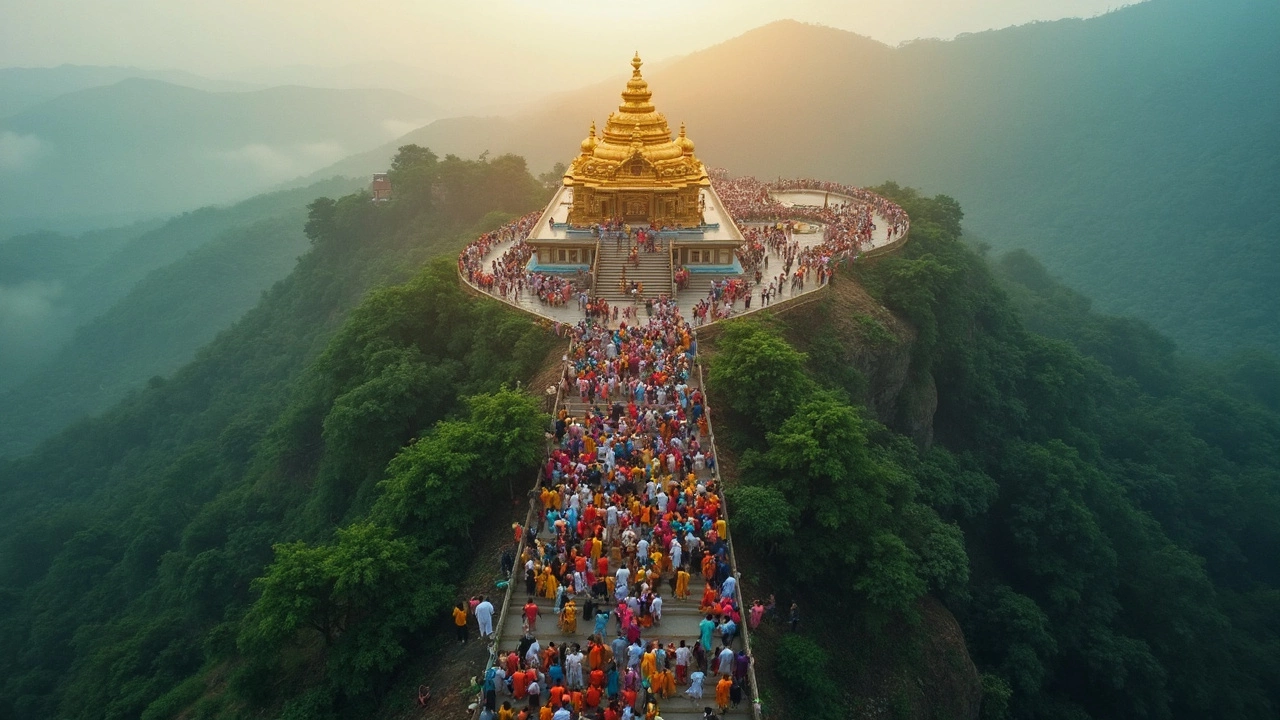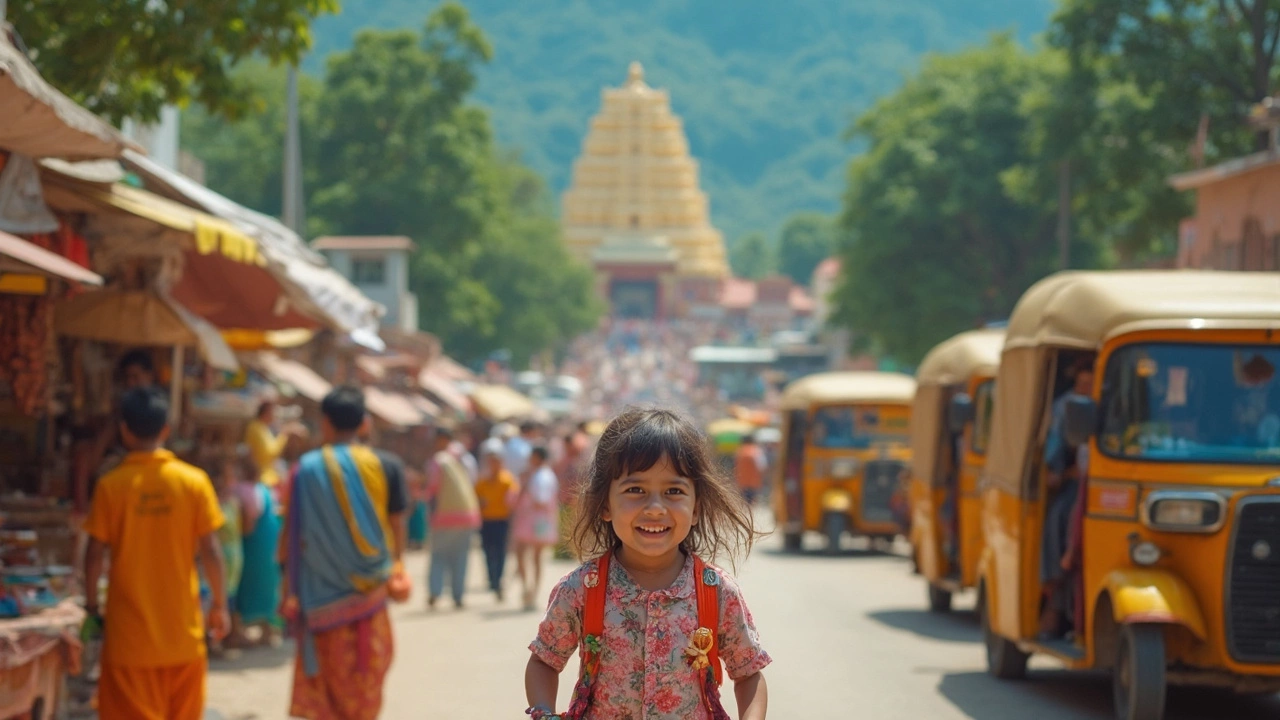Most Visited Temple in India: The Secret Behind Tirupati Balaji's Popularity
 Jun, 28 2025
Jun, 28 2025
Twenty-four hours a day, seven days a week, there’s a place in India where the crowd never thins. Picture this: a sea of people, stretching as far as you can see, some walking barefoot for miles, others climbing hundreds of steps with a mix of excitement and devotion. Some people show up just to shave their heads—yes, for real. Everyone wants a few seconds in front of just one idol. If you haven’t guessed, it’s the Tirupati Balaji Temple, also called the Venkateswara Temple. This temple isn’t just the most visited temple in India. Sometimes, it’s counted among the world’s most visited holy sites—rivaling the Vatican. The numbers are wild: upwards of 50,000 to 100,000 visitors a day, and on special occasions, nearly half a million. So, what’s behind this non-stop buzz?
Where Devotion Never Sleeps: Why Tirupati Balaji Attracts Millions
The Tirupati Balaji Temple sits atop the lush Tirumala hills in Andhra Pradesh. The place is soaked in decades of tradition, but what really grabs you is the never-ending flow of people. On normal days, you’d think the town itself is a festival, with lines winding around corners and security folks with megaphones guiding the crowd. The temple opens before sunrise and even then, you’ll find thousands eager for darshan. The main draw? Lord Venkateswara, an avatar of Vishnu, who’s said to grant wishes. For pilgrims, standing just a few feet from the deity shifts something deep inside—they say the energy feels electric.
Here's a table to get your head around the incredible visitor numbers:
| Year | Estimated Annual Visitors |
|---|---|
| 2016 | 27 million |
| 2017 | 30 million |
| 2018 | 32 million |
| 2019 | 35 million |
| 2022 | 35 million* |
*COVID-19 affected numbers in 2020-2021, but the crowds rapidly returned.
Locals say it’s not just people from Andhra Pradesh. Families trek from every corner of the country—Chennai, Mumbai, Delhi, even NRI families from the US and Europe. Special events like Brahmotsavam supercharge the crowd. Last year, a record half a million showed up over just a weekend, and you can feel the electricity in the air.
The Roots of Tirupati: Myths, History, and Epic Donations
Legends about Tirupati date back thousands of years. Hindu mythology says Vishnu descended here as Venkateswara to save humanity during Kali Yuga. There are fascinating stories—like the temple rising up out of an anthill, or Lord Balaji taking a huge loan from Kubera, the god of wealth, to pay for his wedding, which locals still chip away at with their donations.
Historically, the temple’s been a magnet for kings and celebrities alike. Ancient Chola, Pandya, and Vijayanagara rulers donated jewelry and gold. Even today, you might spot Bollywood stars making discreet visits. One thing that stands out is Tirupati Balaji’s wealth—estimates put it at billions of dollars worth of donations. Just for scale, in 2017, around 1,200 kilograms of gold were offered by devotees. That’s more than some central banks!
But money isn’t the only thing people give here. The temple is famous for tonsuring—people shave their heads to thank the deity for blessings or in the hope of wish-fulfillment. The temple collects 500+ heads shaved an hour on busy days. The hair is auctioned and the money supports charities, education, and temple upkeep, not wasted. And if you’re a foodie, you probably know about the world-famous Tirupati laddu—practically every visitor takes this sacred sweet home.

Experiencing the Rush: Tips for a Smooth Tirupati Visit
If you’re thinking about braving Tirupati’s crowds, a little know-how goes a long way. Here’s what happens: there are queues. Long, winding, maze-like queues. Unless you plan ahead, be ready to wait for hours. During festivals or weekends, the wait for darshan can stretch to 24 hours. You can book “special entry darshan” tickets online (costing roughly ₹300), which speeds things up, but these sell fast—often weeks in advance.
Pro Tip: The temple offers free food (called ‘annadanam’) for everyone—don’t miss it. Over 50,000 meals a day are served, and the menu rotates. For lodging, the temple trust has comfortable rooms and countless budget hotels. Book early, because the rush never sleeps here. If you’re bringing family, pack light and wear comfortable clothes. Cell phones and cameras aren’t allowed in the main temple area, so forget photos—just soak up the moment. Early mornings (before 6 a.m.) and late evenings see slightly smaller crowds. Avoid peak holidays like Vaikuntha Ekadashi or Brahmotsavam unless you enjoy navigating human tides.
- Research different darshan types (free, special entry, and VIP).
- Plan your route if you want to climb the “Sopanam” steps—there are 3,550 steps, but the scenery is worth it.
- Travel light—security is strict and storage options are basic.
- Don’t skip the ladoos (get extra—they keep well).
- If you’re going with elders or kids, opt for protocol darshan tickets through official government channels.
Vendors outside sell everything from trinkets to souvenirs, but the real highlight is the bustling energy in the temple and those few seconds in front of the idol. That’s what visitors remember most—despite the chaos, the connection feels personal and powerful.
Other Heavy-Hitters: Famous Temples and How Tirupati Compares
Tirupati gets the most visited temple in India title, hands down. But there are other temples pulling massive crowds. Vaishno Devi in Jammu, for example, gets around 8 million visitors a year and is one of the most prominent Shakti shrines. The Shirdi Sai Baba Temple, another giant, attracts 25,000 to 100,000 pilgrims daily. And Kashi Vishwanath Temple in Varanasi is hands-down the top pilgrimage spot for Shiva devotees, but its footfall is still dwarfed by Tirupati’s.
So why does Tirupati outpace the rest? Direct connectivity helps—a well-oiled train and bus network, plus an airport only fifteen kilometers away. There’s also an open invitation: people of all backgrounds, regions, or even countries feel welcome. The temple trust runs schools, hospitals, and social services, too, which keeps its reputation high among visitors from diverse backgrounds.
Then there’s celebrity draw. Cricketers, politicians, and movie stars—practically every famous Indian has been spotted climbing the hills or joining the crowd. When you see photos of Sachin Tendulkar or Amitabh Bachchan here, it helps maintain the temple’s place in the limelight, and the stories spread like wildfire.

Why Travelers—Not Just Pilgrims—Are Obsessed With Tirupati
Even if you’re not big on rituals or prayers, Tirupati still has something for you. The temple is an architectural marvel: granite gopurams, gold-plated domes, and ornate pillars that have stood tall for centuries. Art lovers geek out on the murals and carvings. Nature fans rave about the drive up Tirumala’s lush hills, where monkeys line the roads and waterfalls gush after the rains.
Families make a mini-vacation of Tirupati trips. There are museums, parks, and even a massive library with rare ancient manuscripts. Foodies go just for the free prasadam and unique local snacks. And because you’ll spot people from every region and language, it never feels like a closed club—you’re swept into a national festival, every hour of every day. Some people come just to watch the non-stop flow of human devotion; it’s that fascinating.
One quirky detail: the temple’s eco-initiatives. The trust installed massive solar panels and rainwater harvesting systems before most big religious sites bothered. The kitchen that feeds tens of thousands runs on biofuel from kitchen scraps! They’ve set up recycling systems, plastic bans, and more—making this ancient site impressively modern when it comes to sustainability.
So, whether you’re an explorer, history buff, foodie, or on a quest for something deeper—Tirupati Balaji gives you a never-ending story to tell. If you’re making a must-see list for India, this sacred spot absolutely deserves its place at the top.